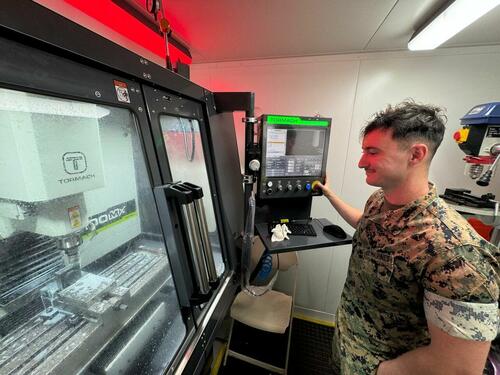The United States Navy is testing industrial-scale 3D printing systems it says could reshape the way it supplies and repairs its ships, aircraft and other equipment, particularly in remote or contested environments where weeks-long waits for parts are not an option.
The demonstrations took place during Trident Warrior, an annual exercise in which the Navy trials advanced technologies under operational conditions. The event is designed to ensure only proven systems advance toward procurement, and it draws heavily on feedback from fleet personnel.
Working alongside the Marine Corps, the Navy showcased 3D printing capabilities that are already in use, some installed in shipping container-sized mobile labs that can be deployed aboard vessels or sent to forward bases. The printers can produce parts ranging from a small hinge to a load-bearing titanium component, and in some cases deliver them off-site via drones or unmanned surface vessels, TheDefensePost.com reports.
“This is Uber for manufacturing, delivered at the speed of Amazon across the globe for nuclear-grade propulsion parts,” Lt. Col. Michael Radigan of the Marine Innovation Unit said in an interview with FOX 5/KUSI. He added that operating such systems in contested environments is one of the program’s most promising – and challenging – aspects.
Jacob Lopez, lead manufacturing technologist at the Naval Surface Warfare Center Corona Division in Fallbrook, Calif., emphasized that the ability to fabricate parts on-site is critical because neither ships nor aircraft can carry every spare they might require.
“We’re using cutting-edge technology,” he said. “We need to make sure our warfighters are safe, we can get them home, and save lives.”
Mr. Lopez cited one example in which a part with a six- to nine-month lead time and a $30,000 replacement cost was produced in just three days. He also trains service members to operate the equipment so they can make battlefield repairs themselves.
The exercise also highlighted “cold spray” repair technology, which can restore a damaged helicopter beam mid-flight – a job that could otherwise require months of work and hundreds of labor hours. Officials said the capability has the potential to save significant time and resources across the fleet.
Military planners see applications that extend beyond mechanical fixes. Lt. Col. Radigan said the same technology could one day be used to produce urgent medical supplies during deployments, further extending the resilience of forces operating far from established supply lines.
Loading recommendations…


















